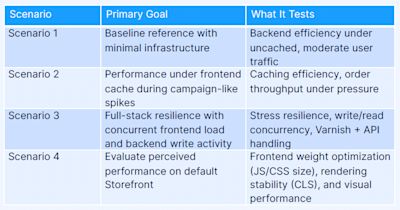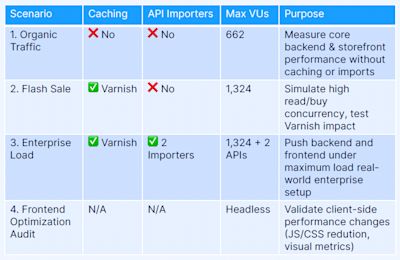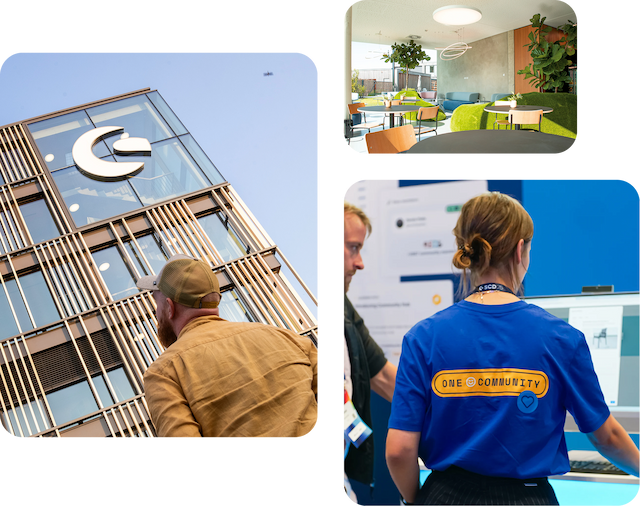
Shopware 6.7 is the latest major release of our open commerce platform – and it comes with a wide range of improvements in accessibility, developer experience, and, most notably, performance.
In this article, we’ll show you how Shopware 6.7 performs compared to the previous version 6.6 across several real-world scenarios – and why your business can benefit from upgrading. For more in-depth technical insights, be sure to check out the Performance Whitepaper, which is available for free download.
How we tested Shopware 6.7’s performance
To evaluate the performance of Shopware 6.7 compared to its predecessor, we conducted extensive load tests using realistic setups and simulated user behavior. Our goal was to determine how Shopware performs under different conditions – from uncached storefront traffic and flash sale scenarios to simultaneous API imports and frontend-only rendering.
We tested Shopware 6.6 and 6.7 under identical infrastructure conditions. Our measurements focused on:
how many requests and orders per second the system could handle
how caching and concurrent API imports impacted stability
how fast and reliably the storefront loaded (e.g., JS/CSS size, CLS)
The following overview shows the specific goal of each test scenario and which performance aspects we focused on:

The results – measurable performance gains with Shopware 6.7
Across all tested scenarios, Shopware 6.7 outperformed its predecessor – in some cases significantly. Whether dealing with regular browsing traffic, high purchasing pressure during a flash sale, or simultaneous API imports, the new version processed more requests and orders with faster response times and lower resource consumption.
Here’s a quick summary of the most important results:
+108% more orders per second in the flash sale scenario with active caching
Latency reduced by up to 85% during simultaneous API load
Up to 39% more requests per second under high system load
~25% smaller JS and CSS payloads thanks to a modern frontend architecture (Vite & Meteor)
The following overview breaks down the load test scenarios in detail – including cache status, API activity, and the number of concurrent users:

Conclusion: Shopware 6.7 delivers measurable improvements across the board – in both backend processing and storefront performance, even under real-world conditions.
How upgrading to Shopware 6.7 improves your store’s performance
Upgrading to Shopware 6.7 isn’t just a technical win – it directly impacts the efficiency and scalability of your ecommerce operations. With targeted improvements in both the backend and storefront, you benefit from:
Stability under heavy load: Whether it’s seasonal peaks, large-scale campaigns, or API-heavy processes – Shopware 6.7 handles significantly more traffic and orders with substantially lower latency.
More efficient operations: With smarter cache usage (e.g., Varnish), reduced background load, and architectural upgrades (e.g., Valkey replacing Redis), your store runs more efficiently – even on mid-sized setups.
Faster storefront: Thanks to the new build system (Vite) and the streamlined Meteor Design System, your storefront loads faster and leaner – enhancing both user experience and conversion rate.
Future-proof technology: The removal of the Store API cache, improved asynchronous processing, and better infrastructure compatibility make Shopware 6.7 especially low-maintenance and ready for future development.
For developers and system architects who take performance seriously and want to scale without technical bottlenecks, upgrading to Shopware 6.7 is a solid foundation.
Performance makes or breaks the customer journey
Fast load times and a stable shop infrastructure aren’t just technical details – they directly influence revenue, customer satisfaction, and long-term ecommerce success.
1. Loss of conversions due to slow pages
According to Neil Patel, a one-second delay in load time can lead to a 7% drop in conversions.¹
Akamai studies show that users expect pages to load in under three seconds. Otherwise, 53% of mobile users abandon the site immediately.²
2. Higher bounce rate & lower retention
Page load times of more than 2–3 seconds significantly increase bounce rates and reduce session duration – by up to 51% for a two-second delay.³
3. SEO impact from poor performance
Since the introduction of Core Web Vitals, Google uses loading speed as a ranking factor.⁴ Slow pages rank lower, reducing organic visibility.
Poor performance can lead to fewer visitors – and less revenue.⁵
4. Brand perception & user experience
According to Forrester, users perceive slow sites as unprofessional. Poor performance hurts brand trust and loyalty.⁶
A fast site improves satisfaction, encourages repeat purchases, and strengthens long-term customer relationships. ⁷
Performance drives conversions – or causes drop-offs
Especially in times of economic uncertainty, where customer decisions are often made through quick comparisons, performance is no longer a nice-to-have – it's a dealbreaker. A technically optimized Shopware instance means:
higher conversion rates
lower resource usage
better scalability during traffic spikes
And that’s exactly what Shopware 6.7 is designed to deliver – with targeted improvements in both backend (caching, APIs, architecture) and frontend (leaner code, resource-efficient build tools).
Learn more in the Performance Whitepaper
Want to dive deeper? The official Performance Whitepaper for Shopware 6.7 includes all technical details and benchmarking results – directly compared to Shopware 6.6 and broken down by scenario, metric, and infrastructure setup.
You’ll learn:
how different caching strategies impact overall performance
the role of API imports under high load
how Shopware 6.7 scales even on mid-sized infrastructure
how new components like Valkey and Vite contribute to speed gains
Whether you're planning to upgrade or simply looking for technical insights into Shopware 6.7 – the whitepaper gives you the data you need.
Sources
¹ ² creatuity.com – The critical importance of website speed in ecommerce ³ bambooagile.eu – Why site speed is important for ecommerce ⁴ creatuity.com – Core Web Vitals impact ⁵ ⁷ digitalsilk.com – Website speed statistics ⁶ thecommerceteam.com – Why ecommerce site speed is important











